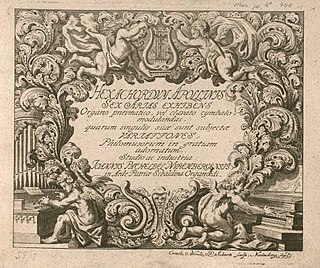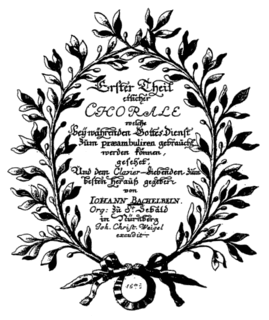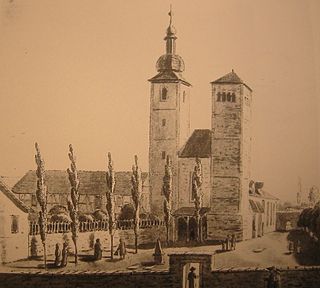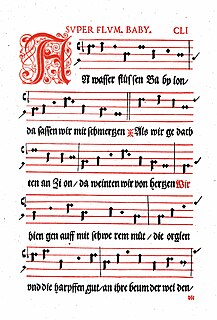Johann Pachelbel was a German composer, organist, and teacher who brought the south German organ schools to their peak. He composed a large body of sacred and secular music, and his contributions to the development of the chorale prelude and fugue have earned him a place among the most important composers of the middle Baroque era.

Dieterich Buxtehude was a Danish organist and composer of the Baroque period, whose works for the organ represent a central part of the standard organ repertoire usually performed at recitals and church services. As a composer who worked in various vocal and instrumental idioms, Buxtehude's style greatly influenced other composers, such as his student Johann Sebastian Bach. Historically, Buxtehude is among the important composers of the mid-Baroque period in Germany.

A chaconne is a type of musical composition popular in the baroque era when it was much used as a vehicle for variation on a repeated short harmonic progression, often involving a fairly short repetitive bass-line which offers a compositional outline for variation, decoration, figuration and melodic invention. In this it closely resembles the passacaglia.

The passacaglia is a musical form that originated in early seventeenth-century Spain and is still used today by composers. It is usually of a serious character and is often, but not always, based on a bass-ostinato and written in triple metre.

Pachelbel's Canon is an accompanied canon by the German Baroque composer Johann Pachelbel in his Canon and Gigue for 3 violins and basso continuo. It is sometimes called Canon and Gigue in D or Canon in D. Neither the date nor the circumstances of its composition are known, and the oldest surviving manuscript copy of the piece dates from the 19th century.

Johann Caspar Kerll was a German baroque composer and organist. He is also known as Kerl, Gherl, Giovanni Gasparo Cherll and Gaspard Kerle.

The sonatas and partitas for solo violin are a set of six works composed by Johann Sebastian Bach. They are sometimes referred to in English as the sonatas and partias for solo violin in accordance with Bach's headings in the autograph manuscript: "Partia" was commonly used in German-speaking regions during Bach's time, whereas the Italian "partita" was introduced to this set in the 1879 Bach Gesellschaft edition, having become standard by that time. The set consists of three sonatas da chiesa in four movements and three partitas in dance-form movements. The 2nd Partita is widely known for its Chaconne, considered one of the most masterly and expressive works ever written for solo violin.

Passacaglia and Fugue in C minor is an organ piece by Johann Sebastian Bach. Presumably composed early in Bach's career, it is one of his most important and well-known works, and an important influence on 19th and 20th century passacaglias: Robert Schumann described the variations of the passacaglia as "intertwined so ingeniously that one can never cease to be amazed."

André Raison was a French Baroque composer and organist. During his lifetime he was one of the most famous French organists and an important influence on French organ music. He published two collections of organ works, in 1688 and 1714. The first contains liturgical music intended for monasteries and a preface with information on contemporary performance practice. The second contains mostly noëls.
The 17th century organ composers of Germany can be divided into two primary schools: the north German school and the south German school. The stylistic differences were dictated not only by teacher-pupil traditions and international influences, but also by separate organ building traditions: northern organs tend to have a tower layout with emphasis on the pedal division, while southern and Austrian instruments are typically divided around a window and emphasize manual divisions.
Johann Krieger was a German composer and organist, younger brother of Johann Philipp Krieger. Born in Nuremberg, he worked at Bayreuth, Zeitz, and Greiz before settling in Zittau. He was one of the most important keyboard composers of his day, highly esteemed by, among others, George Frideric Handel. A prolific composer of church and secular music, he published several dozen of his works, and others survive in manuscript. However, hundreds more were lost when Zittau was destroyed by fire in 1757, during the Seven Years' War.
Passacaglia in D minor is an organ work by Dieterich Buxtehude. It is generally acknowledged as one of his most important works, and was possibly an influence on Bach's Passacaglia and Fugue in C minor, as well as Brahms' music.

Hexachordum Apollinis is a collection of keyboard music by Johann Pachelbel, published in 1699. It comprises six arias with variations, on original themes, and is generally regarded as one of the pinnacles of Pachelbel's oeuvre. The collection includes a preface in which Pachelbel dedicates the work to Dieterich Buxtehude and Ferdinand Tobias Richter and briefly discusses the nature of music.

Erster Theil etlicher Choräle is a collection of liturgical organ music by Johann Pachelbel, published during his lifetime. It contains eight chorale preludes in seven different styles.

Andreas Armsdorff was a German composer and organist. He was born in Mühlberg, near Gotha, and studied music and law. At some point in his early life he moved to nearby Erfurt where he may have studied with Johann Pachelbel. He worked as organist in various churches in Erfurt: Reglerkirche, Andreaskirche, and Kaufmannskirche. He died in Erfurt at the age of 29.
Musicalische Ergötzung is a collection of chamber music by Johann Pachelbel. Published during his lifetime, it contains six suites for two violins and basso continuo.
Chaconne in F minor is an organ chaconne by Johann Pachelbel. One of the six surviving chaconnes by the composer, it is one of his best known organ works.

"An Wasserflüssen Babylon" is a Lutheran hymn by Wolfgang Dachstein, which was first published in Strasbourg in 1525. The text of the hymn is a paraphrase of Psalm 137. Its singing tune, which is the best known part of the hymn and Dachstein's best known melody, was popularised as chorale tune of Paul Gerhardt's 17th-century Passion hymn "Ein Lämmlein geht und trägt die Schuld". With this hymn text, Dachstein's tune is included in the Protestant hymnal Evangelisches Gesangbuch.
The Andreas Bach Book is an important collection of 18th century European organ and harpsichord music compiled around 1708, named after Andreas Bach, who was one of the owners of the collection, as well as the nephew of Johann Sebastian Bach. The main scribe of the anthology was Johann Christoph Bach, Johann Sebastian's elder brother and father of Andreas. Along with the Möller Manuscript, the Andreas Bach Book represents the earliest major source of the works of J.S. Bach, housing the earliest known copies of the famous Passacaglia and Fugue in C minor, BWV 582 and Fugue in G minor, BWV 578.












